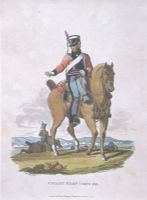
1813 Aquatint by J.C. Stadler after Charles Hamilton Smith
©None
1813 Aquatint by J.C. Stadler after Charles Hamilton Smith
|
We have become very familiar, understandably, with the details of those who served and died in the First World War. But the Cemetery also contains the relics of those who served at other times and in other campaigns and one of these is highlighted here.
Charles Stone, born c.1781 in Burbage, Wiltshire. He enlisted in the army in 1800 and became a Corporal in the 2nd Dragoon Guards, popularly known as The Queen’s Bays. His army record shows him to be of good character and sound performance which led to him being selected in 1813 to join an important but little known unit – the Peninsular Staff Corps of Cavalry. This became the first standing military police force, under the control of the Adjutant-General’s Office. In addition to its policing role, it undertook escort and other staff-related duties and on occasion was employed as combat cavalry. Members of the Staff Corps of Cavalry wore a red scarf tied around the right shoulder of their regimental uniform, which is believed to be origin of the “Red Cap” of the Royal Military Police, which came into existence in 1855. Amongst various disciplinary functions the Staff Corps was responsible for patrolling the battlefield after the event to prevent looting, pillage and robbing the dead and dying.
Charles Stone’s death announcement states he was “formerly a sergeant in the 2nd Dragoon Guards (a Waterloo veteran)” but we have been unable to find any definitive record of this. But it is entirely possible that he was, due to his experience, on secondment/detached duty or amongst the reinforcements rushed to Belgium to boost Wellington’s Army, but they would have arrived after the battle. The 2nd Dragoon Guards were sent to France and quartered in Paris with the King’s Dragoon Guards who had fought in the battle. The following year they were at St. Omer and during 1817 they were in the area of Calais before going to Cambrai. The Bays were finally sent home in November 1818.
From the Chelsea Pension records we know that Charles Stone served in the Army for 21 years and 205 days. At the time of his discharge in August 1821, aged 41, he is shown as being 5 foot 9 inches tall, light hair with grey eyes and fair complexion. The reason for his discharge was “suffering from frequent attacks of haemorrhage from the lungs with consequent asthma and increasing debility”. It is recorded that early on in his career his horse fell on him when leaping a bar in the Riding School at Tullamore, Ireland, rupturing one of his blood vessels. On 24th October 1821 he was admitted into the Royal Hospital, Chelsea, and the 1841 census confirms he was still in residence (3rd Ward).
In the 1851/1861 census he is living in Wallingford Street, Wantage with his French wife, Catharine, who was born in Cambrai. At an unknown date Charles and his wife made their home in Newbury where he died on 15th February 1870, aged 89, at Dredge’s Yard, Bartholomew Street, and he was buried on 19th February 1870. The death certificate gives the cause of death as “decay of age”. His widow Catharine died in 1875 in Burbage, Wiltshire, at the age of 89 years and the burial records at All Saints Church, Burbage, confirm she was buried on 17th March 1875.
Sources:Various |
|
|

